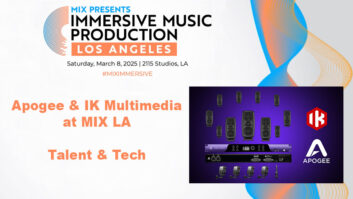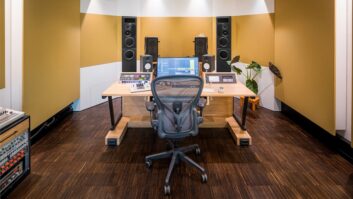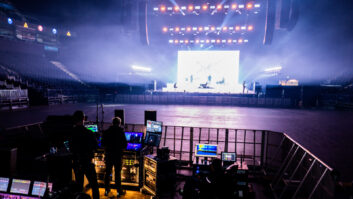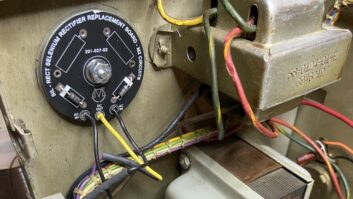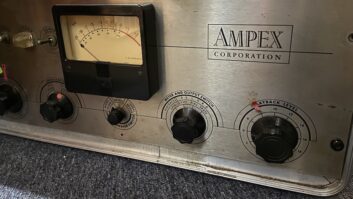Copper is dead, long live glass. That’s an exaggeration, of course; copper cable as a transport for both analog and digital signals is still alive and kicking. But as more houses of worship adopt digital workflows for live sound, recording and broadcast production, fiber optic cables are becoming an attractive alternative.
“I can’t remember the last time I ordered a snake for a church or an install; sometimes I look in our warehouse and I see all the snakes on the top shelf,” says Mitch Shaivitz, account manager at Guitar Center Pro’s Towson, MD location. “I have ordered some mini snakes and some 25-foot six-channel drop snakes for a church, but for the life of me, I can’t remember the last time I did that.”
The popularity of analog multiway snakes has decreased as the price of copper has increased and as networked data workflows have replaced point-to-point analog signals. “With the expense and the price of copper, there’s no point running copper anymore, especially with digital technology. For medium to larger-sized house of worship projects, I’m doing everything with Cat 5 digital snakes, including the one I’m doing now, where we’re running Cat 5 and Dante all over the building.”
“We still sell a lot of the old, standard analog copper cables,” reports Daryl Greenway, sales manager at Whirlwind in Rochester, NY. “I would say the channel count is getting less, but we still sell a lot of our six-, 12 -, 16- and 24-channel drop boxes.”
Whirlwind makes, well, pretty much any type of cable or patch panel, and offers almost limitless custom options. The latest and greatest cable that Whirlwind introduced, says Greenway, is the result of requests from contemporary churches and praise bands. “Our hybrid cables came into play from feedback from churches saying they had in-ear monitors and little onstage mixers driven by data,” he says. “These day, houses of worship are driving technology. They have budget and imagination.”
These hybrids combine audio and data in a single cable. “Belden make it for us; they squash everything into a tiny, little, thin cable that looks like an audio cable,” says Greenway. The cables are each available with six, 12, 20 or 32 audio channels plus two Cat 6 cables.
“That’s great for in-ear monitors and anything that carries data. It can have [Neutrik] Ethercon connectors at both ends, but it doesn’t have to. We sell a ton of them. We’re actually running out of the cable quicker than we can make them,” he says.
“From the information we’ve recently gathered from the market, many houses of worship have existing coax; it has historically been used in older facilities,” says Shadath Shahid, engineering manager with Canare Corporation of America in Totowa, NJ. “With the need for shorter runs and smaller networks, a lot of these facilities want to go faster and they’re looking to convert a lot of this over to fiber. We’re not seeing it happen very quickly, but eventually the future is in fiber cable and panels.”
So, he continues, “Our primary focus is trying to get people to convert from the old snake cables to newer products like fiber with SMPTE connectors and various types of panels.” Whether they convert depends on available budgets, of course. “But everybody wants to go larger and push at faster speeds. And to be compatible with many of the cameras and equipment on the market, they are being forced to go with fiber technology,” he says.
Even in older facilities, fiber is starting to take root. Houston, TX’s Memorial Drive Presbyterian Church recently bought a Studer Vista 1 desk from GC Pro. Installed earlier this year, the desk is used to route audio to a number of locations around the church campus.

That said, Canare still sells plenty of copper cable. “Our flagship cable is the L4E6S. We still provide that; it’s a bestseller,” says Shahid. “It’s known as Canare Star-Quad cable. It reduces a lot of the IM [intermodulation]; there’s no noise. It’s commonly used for microphone cables and live sound audio applications.”
These days, it appears that every house of worship, from the largest megachurch to the smallest 100-seater, broadcasts—or at least, webcasts—its services. At the project on which Shaivitz is currently working, category cable will enable signals to be easily shared between the audio consoles, he says.
“They have a broadcast booth in the upper balcony and we’re using the front-of-house console to run Dante up to that console. From there, they will be able to do all their audio for broadcast, then feed it out with video. Further down the road, they want to be able to network audio and record it.
“We’re using Dante to run audio from the broadcast booth to their offices, to laptops. It’s a nice, easy solution. And Dante is not going away,” he adds, noting Audinate’s recent announcement that more than 1,000 different Dante-enabled products are now on the market.
At another recent installation, says Shaivitz, Cat 5 was an easier solution than a copper snake, not least because most of the room was concrete, making it more difficult to hide bulky cables. GC Pro is installing Allen & Heath GLD consoles, AudioRack stageboxes and ME personal monitor mixers with a Dante network running over Cat 5 at the current church project, he says.
Canare focuses on custom panels rather than stage boxes, says Shahid. “We have panels that have SMPTE connectors; we can configure those in many different ways, depending on the application, depending on the camera that is being used. We have many types of what we call COPS system panels, that can be configured male/female depending on what type of HD camera or terminal is being used,” he says.
As for fiber, “We have single mode, multi-mode; we have conversion boxes. And for some of these larger houses of worship that are doing big broadcasts, if they have OB vans coming to their locations, we also have all the different interconnects for the OB van, and to the studio and the facility,” says Shahid.
The popularity of Cat 5 has also given rise to new products that simplify audio signal distribution, says Shaivitz. “There are all these companies like ProCo and Radial making these simple, little boxes with a four-channel XLR converter over Cat 5. They work great.”
Radial’s Catapult, as an example, encompasses four XLR inputs and outputs plus two Ethercon outputs. The box supports several applications. But at its simplest, Catapult enables operators to send four analog or eight AES digital audio signals over Cat 5/6 to more remote locations, such as choir lofts.
Whirlwind also makes a 4-channel Cat 5 snake, says Greenway. “And we have a fiber department. We’re doing a lot of long-run fiber cables on reels, including with converters at both ends to convert them to Cat 5. We can put them in cases because we have our own case department. Churches like the fact that it’s a small, thin black cable that you don’t see, even if you run it down the aisle.”
Greenway is the “new guy” at the 40-year-old company, despite working at Whirlwind for 10 years. “There are guys who have been here for 20, 25, 30 years, so there’s a lot of real knowledge here. We’ve been around for a long time, so we know what we’re doing. I encourage people to contact me; I’ll sit and have a chat with somebody for an hour about designing their new snake set-up, then we put them through a dealer.”
Whirlwind offers pre-wired stage pockets as well as multipin snakes for location on a drum riser, for example. It may be quickly disconnected or reconnected when the riser is moved off or onto the stage. The company also offers custom metalwork, such as rack panels, custom artwork and other options. “We are very much a bespoke custom shop,” he says, “and that doesn’t always mean expensive.”
Color coding of cables and connectors can be helpful at houses of worship, where lay volunteers may be assisting church production staff. “What you tend to find is that the church audio guy is very knowledgeable, whereas the guys who are plugging it all in aren’t necessarily,” Greenway observes.
With so many options available, discussing designs directly with a customer eliminates the possibility of any mistakes. “We know our capabilities, which are pretty much endless,” he says. “I know that sounds like a bit of a sweeping statement, but as long as it’s audio, it’s doable.”
Guitar Center Pro
guitarcenter.com/GC-Pro
Whirlwind
whirlwindusa.com
Canare
canare.com
This article originally appeared in the April 2017 edition of HOW Sound as “Making The Connection.”
